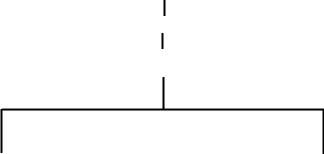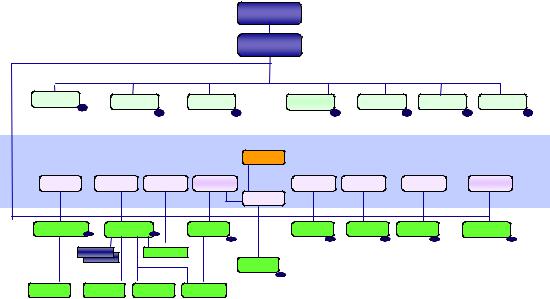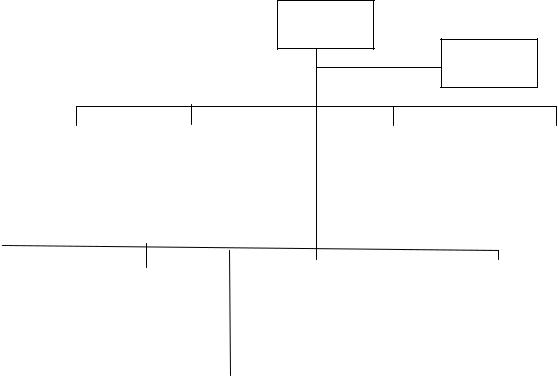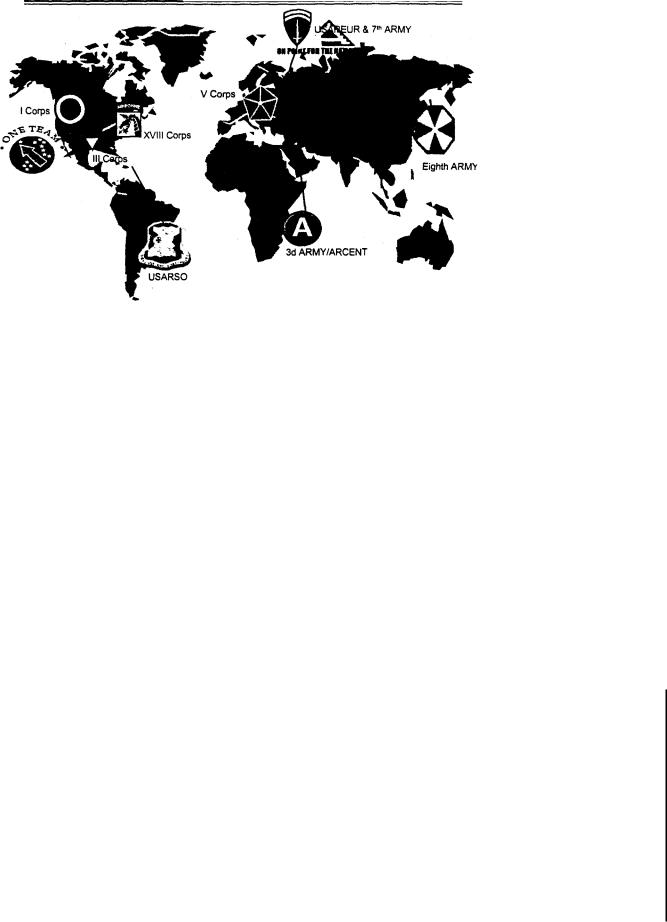
(классная обзорная вещь) NWC_Joint_Ops_Guide
.pdf
ships come under the operational control of Commander, Surface Group Six, who is assigned to Commander, Naval Reserve Force. 32 percent of Selected Reserve personnel are assigned to commissioned units.
Augmentation Units: Units that augment Active component units with trained personnel. Such units are tailored to augment designated ships, special warfare commands, intelligence staffs, etc. Their function is to allow for peak operations for an indefinite period of time. They also provide surge capability, and then sustain the high level of activity to support deployed forces.
Roles, Missions, and Functions: The function of the Naval Reserve is to provide trained and qualified personnel and units to provide swift augmentation to the Navy. The Naval Reserve is composed of personnel in the Selected Reserve, the Individual Ready Reserve, and the Retired Reserve. The Selected Reserve is the primary source of units and personnel for immediate expansion of the Navy. The Naval Reserve is an integral part of the Navy's total capability across the full spectrum of conflict and is available for crisis response and contributory support.
Naval Reserve Command and Control
Secretary of the Navy
Chief of Naval Operations
Commander, Naval Reserve Forces*
Naval Air |
Naval Surface |
Naval Reserve |
Reserve Forces |
Reserve Forces |
Recruiting |
*The Commander, Naval Reserve Forces also serves as Director, Naval Reserve and as Chief of Naval Reserve
18
U.S. ARMY*
I. Mission and Purpose
Title 10 USC
In general, the Army within the Department of the Army, includes land combat and service forces and such aviation and water transport as may be organic therein. It shall be organized, trained, and equipped primarily for prompt and sustained combat incident to operations on land. It is responsible for the preparation of land forces necessary for the effective prosecution of war except as otherwise assigned and, in accordance with integrated joint mobilization plans, for the expansion of the peacetime components of the Army to meet the needs of war.
FM 1, THE ARMY, June 2001
The Army contributes forces to combatant commands to conduct prompt and sustained combat operations on land. The objective of Army forces is land force dominancedefeating adversary land forces, seizing and controlling terrain, and destroying the adversary will to resist. The Army has the capability to bring conflict to decisive, lasting resolution. The Army, supported by the Air Force and Navy, has forcible entry capability that allows it to conduct land operations anywhere in the world. The Army also can achieve prompt and sustained land dominance across the spectrum of conflict. It concludes conflict decisively to achieve national political and military objectives.
The Army’s unique, sustained land power capabilities offer the National Command Authorities and combatant commanders more options for engagement, crisis response, and warfighting.
U.S. Army Posture Statement 2003
America’s military is the most powerful in the world, and The Army remains the most respected land power to our allies, the most feared ground force to those who would threaten the interests of the United States. For over 227 years, the American Soldier has been fulfilling the Army’s non-negotiable contract with the American people to fight and win our nations wars-decisively.
The Army is in the midst of one of the most profound periods of transformation in our history. In October 1999, we unveiled our vision for future-“Soldiers on point for the Nation, transforming this, the most respected Army in the world, into a strategically responsive force that is dominant across the full spectrum of operations.
The attacks against our nation and the ongoing Global War on Terrorism (GWOT) validate the Army’s Vision-People, Readiness, and Transformationand our efforts to quickly change into a more responsive, more deployable, more agile, more versatile, more lethal, more survivable, and more sustainable force. The Stryker Brigade Combat Teams-our Interim Force,- will bridge the gap between our lethal heavy forces and our rapidly deployable light forces even as they prepare for way for the arrival of the Objective Force.

*The source of this information are direct excerpts from Army Employment Data, May 2003, U.S. Army War College, Carlisle Barracks, Pennsylvania as revised by John A. Bonin, COL, USA (Retired), Concepts and Doctrine Office. While most of the information has been copied verbatim, edits to the text have been made for this audience.
II. Army Organization and Concept of Operations
There are two branches to the US military chain of command. Subject to the authority, direction, and control of the Secretary of Defense and the provisions of Title 10 United States Code, the Department of the Army operates under administrative command of the Secretary of the Army with the advice of the Chief of Staff. In carrying out its functions as prescribed in DOD Directive 5100.1 the U.S. Army currently has fifteen Major Commands and seven other three star level commands. Nine of these commands are also Army component commands of unified or subunified joint commands. See Figure 1.
Army Organization FY 2003
MACOMs, Army Component Commands, and 3 Star HQ
SECDEF
HQDA
MEDCOM |
INSCOM |
TRADOC |
USACE |
AMC |
MDW |
CIDC |
|
1 |
|
|
|
|
|
|
2 |
3 |
4 |
5 |
6 |
7 |
Institution Support
UNIFIED COMMANDS |
|
UNC/CFC |
|
|
|
||
|
|
|
|
SUBUNIFIED |
|
|
|
EUCOM |
JFCOM |
CENTCOM |
PACOM |
COMMAND SOUTHCOM |
SOCOM |
STRATCOM |
TRANSCOM |
|
|
|
|
USFK |
|
|
|
USAREUR/7A |
8 FORSCOM 9 |
USARPAC |
USARSO |
USASOC |
SMDC |
MTMC |
|
|
|
|
10 |
12 |
13 |
14 |
15 |
|
XXXX |
xxxx |
OPCON |
|
|
|
|
1/5 |
CONUSA |
ARCENT/3A |
x xxx |
|
|
|
|
|
|
|
|
|
|
|
|
|
|
|
|
EUSA |
|
|
|
xxx |
xxx |
xxx |
xxx |
11 |
|
|
|
|
|
|
|
||||
V |
III |
XVIII |
I |
|
|
|
|
In January 2003, the Army announced its plan to transform Major Commands and Field Operating Agencies. MEDCOM, INSCOM, MDW, and CIDC will become Direct Reporting Units (DRU) to designated Headquarters DA staff principals. In addition, The Network Enterprise Technology Command (NETCOM) created out of FORSCOMs former Army Signal Command will also be a DRU.
I. COMBATANT WARFIGHTING UNITS

U.S. Unified Commands and Army Components. Currently nine Unified Combatant Commands exist. Their missions are assigned by the Secretary of Defense with the advice and counsel of the Chairman of the Joint Chiefs of Staff. Most Unified Commands consist of Army, Navy, Air Force, and Marine Corps components. The Major Army Command (MACOM) assigned as the Army component of its respective Unified Command are shown in Figure 2. The Third US Army is a subordinate element of Forces Command as well as being the Army component of the US Central Command. The US Army Space Command is an element of the US Army Space and Missile Defense Command as well as being the Army component of the new US Strategic Command (now also responsible for space). All these units are trained and equipped for combatant warfighting missions---they may also be assigned operations other than war during peace and periods of conflict.
Secretary of
Defense
Chairman of
The JCS
|
|
European |
|
|
|
Pacific |
|
|
|
|
|
|
|
Southern |
|
|
Central |
||||||
|
|
|
|
|
|
|
|
US |
|
|
|
|
|||||||||||
|
|
Command |
|
|
|
Command |
|
|
|
|
|
Command |
|
Command |
|||||||||
|
|
|
|
|
|
|
Forces |
|
|
|
|||||||||||||
|
|
|
|
|
|
|
|
|
|
|
|
|
|
|
|
|
|
|
|
|
|||
|
|
|
|
|
|
|
|
|
|
|
|
|
|
Korea |
|
|
|
|
|
|
|
||
|
|
|
|
|
|
|
|
|
|
|
|
|
|
|
|
|
|
||||||
|
|
|
|
|
|
|
|
|
|
|
|
|
|
|
|
|
|
||||||
|
|
USAEUR & |
|
|
|
USARPAC |
|
|
|
|
|
|
USARSO |
|
ARCENT & |
||||||||
|
|
|
|
|
|
|
|
|
|
|
|
||||||||||||
|
|
7th Army |
|
|
|
|
|
|
|
|
|
8thArmy |
|
|
|
|
3rd Army |
||||||
|
|
|
|
|
|
|
|
|
|
|
|
||||||||||||
|
|
|
|
|
|
|
|
|
|
|
|
|
|
|
|
|
|
|
|
|
|
|
|
|
|
|
|
|
|
|
|
|
|
|
|
|
|
|
|
|
|
|
|
|
|
|
|
|
|
|
|
|
|
|
|
|
|
|
|
|
|
|
Strategic |
|
Special Ops |
|
|
||||
North |
|
|
Joint Forces |
|
|
|
|
|
|
|
|
||||||||||||
|
|
|
|
|
|
|
Command |
|
Command |
|
|
||||||||||||
Command |
|
|
Command |
|
|
|
|
|
|
|
|
||||||||||||
|
|
|
|
|
|
|
|
|
|
|
|
|
|
|
|
||||||||
|
|
|
|
|
|
|
|
|
|
|
|
|
|
|
|
|
|
|
|
|
|
|
|
|
|
|
|
|
|
|
|
|
|
|
|
|
|
|
|
|
|
|
|
|
|
|
|
|
|
|
|
|
|
|
|
|
|
|
|
|
|
|
|
|
|
|
|
|
|||
|
|
|
|
|
|
|
|
|
|
|
|
|
|
|
Army Space |
|
Army Special |
|
|||||
|
|
|
FORSCOM |
|
|
|
|
|
|||||||||||||||
|
|
|
|
|
|
|
|
Command |
|
Ops Command |
|
||||||||||||
|
|
|
|
|
|
|
|
|
|
|
|
|
|
|
|
|
|||||||
|
|
|
|
|
|
|
|
|
|
|
|
|
|
|
|
|
|
|
|
|
|
|
|
|
|
|
|
|
|
|
|
|
|
|
|
|
|
|
|
|
|
|
|
|
|
|
|
|
|
|
|
|
|
|
|
|
|
|
|
Transportation |
|
|
|
|
|
|
|
||||
|
|
|
|
|
|
|
|
|
|
|
|
Command |
|
|
|
|
|
|
|||||
|
|
|
|
|
|
|
|
|
|
|
|
|
|
|
|
|
|
|
|
|
|
||
|
|
|
|
|
|
|
|
|
|
|
|
|
|
|
|
|
|
|
|||||
|
|
|
|
|
|
|
|
|
|
|
|
MTMC |
|
|
|
|
|
|
|
|
|||
|
|
|
|
|
|
|
|
|
|
|
|
|
|
|
|
|
|
|
|
|
|
|
|
The specific missions and organizational structure of each are presented in the following nine subsections:
•US Army Europe and Seventh US Army (USAREUR)
Mission
-Responsible for defense of US interests in Western Europe
-Maintain a combat ready force to support NATO commitments.
-Maintain trained and ready forces for deployment on contingency operations in support of US European Command (EUCOM) and US Central Command (CENTCOM) missions.
Organization
-Major Army Command and Army Service component of US EUCOM
-Commands US Army units in Germany, Italy, England, and the Netherlands
-Includes V Corps, 1st Armored Division, 1st Infantry Division, Southern European Task Force (with the173d Airborne Brigade (Separate), 21st Theater Support Command, and Area Support Groups
•US Army South (USARSO)
Mission
-Command and control Army Forces in the US Southern Command
-Provide theater support for US Army Forces and Headquarters USSOUTHCOM as directed by USCINCSO
-Plans, programs, and provides US Army support for USCINCSO’s regional security strategy.
Organization
-Major Army Command and Army Service component of US Southern Command
-Organized around major subordinate elements which consist of forward stationed aviation and signal units, as well as the Ft. Buchanan, PR Garrison.
-USARSO HQ will move to Ft Sam Houston in 2004 and become a subordinate of FORSCOM.
•US Army Pacific (USARPAC)
Mission
-Serve as the Army Service Component Command to Combatant Commander, US Pacific Command less the geographical area of Korea
-Command and support assigned and attached active Army and USAR units, installations, and activities in Alaska, Hawaii, Japan, and in possessions and trust territories administered by the US Pacific Command (USPACOM)
-Oversee, evaluate, and support the Army National Guard in Hawaii, Alaska, and Guam
-Maintain a trained and ready force for employment in the Pacific theater or worldwide
Organization
-Major Army Command
-Subordinate Units: 25th Infantry Division (Light); 172d Infantry Brigade (Separate) and US Army Garrison, Alaska; US Army Japan and 9th Theater Support Command; US Army Chemical Activity Pacific; 196th Infantry Brigade (Training Support Pacific); and 9th U. S. Army Regional Support Command.
•Eighth US Army (EUSA)
Mission
-Provide forces to the Combined Forces Command/US Forces Korea to deter aggression against the Republic of Korea (ROK) and, should deterrence fail, to defeat that aggression.
Organization
-US Major Army Command and Army Service component of U.S. Forces Korea whose ground and aviation forces come under operational control of the Combined Forces Command in wartime
-Major subordinate units: 2nd Infantry Division; 6th Cavalry Brigade (Air Combat); 17th Aviation Brigade; 18th Medical Command; and the 19th Theater Support Command.
-Largest component of the US Forces Korea which also includes US Air Forces, Korea (7th Air Force), and US Naval Forces Korea
-Commands assigned USAR units
•US Army Forces Command (FORSCOM)
Mission
-Responsible for mobilization planning and combat readiness of assigned active Army and USAR units and training supervision of Army National Guard during peacetime
-Responsible to NORTHCOM for planning the land defense of Continental United States (CONUS) and the combined Canada - United States defense of Canada,
-Provides support to civil authorities in domestic emergencies
-Provides support to federal, state, and local law enforcers in Homeland Security.
Organization
-Major Army Command and Army Component of US Joint Forces Command and provides Third US Army as Army component to US Central Command
-Provides support to NORTHCOM when designated.
-FORSCOM commands assigned active Army units in CONUS, the Continental U.S. Armies (CONUSAs), and when federalized Army National Guard units. Commands US Army Reserve Command and Army Reserve units in CONUS, Puerto Rico, and Virgin Islands.
-The major subordinate commands of FORSCOM are; three Army corps, two CONUSAs, the US Army Reserve Command, and Third U.S. Army. Major subordinate commands and locations:
Corps: |
I (COCOM PACOM) |
Fort Lewis, WA |
|
III |
Fort Hood, TX |
|
XVIII |
Fort Bragg, NC |
CONUSAs: |
First Army |
Fort Gillem, GA |
|
Fifth Army |
Fort Sam Houston, TX |
Third U.S. Army (ARCENT) |
Fort McPherson, GA |
|
Army Service component of USCENTCOM |
|
|
USA Reserve Command (USARC) |
Atlanta, GA |
|
Other deployable FORSCOM Echelons Above Corps (EAC) units include: 7th Trans Group (Composite) - Ft. Eustis
32d Air and Missile Defense Command-Ft. Bliss 11th and 35th ADA Bdes - Ft. Bliss
52d Explosives Ordnance GroupFt. Gillem, GA
49th Quartermaster Group Ft. Lee, VA.
•Third US Army and US Army Central Command (USARCENT)
Mission
-Develop and coordinate requirements, plans and participation of US Forces in regional exercises and contingencies
-Provide Command and Control of assigned and attached US Army forces in the USCENTCOM area.
-Be prepared to deploy worldwide in support of JCS contingencies
Organization
-Designated US Army Forces Central Command (USARCENT) as the Army Service component command of US Central Command (USCENTCOM).
-Under the combatant command (COCOM) of USCENTCOM
-Command and control of assigned and attached US Army forces in wartime as in Operation Desert Storm
-Major subordinate, less COCOM, of US Army Forces Command
-Has as permanent subordinates, ARCENT-Kuwait, Saudi Arabia, and Qatar.
•US Army Space Command (USARSPACE)
Mission
-Command Defense Satellite Communications System Operation Centers and manage joint tactical use
-Conduct planning as the “User” of Army Strategic Ballistic Missile Defense
-Execute operational demonstrations of the Army Space Exploitation Demonstration Program
Organization
-As a major subordinate command of US Army Space and Missile Defense Command (USASMDC), the Army Space Command is the Army component of US Strategic Command (USSTRATCOM)
-Subordinate elements in Germany, Okinawa, Hawaii, California, Maryland, and Virginia
-The 1st Space Brigade provides Army Space Support Teams, Space Electronic Warfare Detachments, and JTAGS Detachments to Army Service Components.
•US Army Special Operations Command (USASOC)
Mission
-Provide trained and ready Special Forces, Ranger, Special Operations Aviation, Psychological Operations and Civil Affairs Forces to Warfighting Commanders-in-Chief, Joint Task Force Commanders, and US Ambassadors and their country teams.
-Responsible for development of unique special operations doctrine, tactics, techniques, procedures, and materiel in coordination with USSOCOM, TRADOC, and AMC
-Responsible for coordinating and deployment of security assistance teams to support friendly nations.
Organization
-Army component command of US Special Operations Command
-Major Army Command responsible for all continental US-based Army Special Operations Forces (Active, Army Reserve, and National Guard)
-Major subordinate commands: US Army John F. Kennedy Special Warfare Center and School; USA Special Forces Command, US Army Civil Affairs
and Psychological Operations Command, 160th Special Operations Aviation Regiment, 75th Ranger Regiment, and US Army Special Operations Support Command.
•US Army Military Traffic Management Command (MTMC)
Mission
-Responsible for global traffic management, operation of worldwide water ports and Department of Defense transportation engineering
Organization
-A jointly-staffed Major Army Command and Army component of the US Transportation Command
-Subordinate overseas area commands in Europe and the Pacific – active and reserve component elements located worldwide.
·Network Enterprise Technology Command (NETCOM) Formerly Army Signal Command (Ft. Huachuca) is a direct reporting unit to the Army CIO/G6 and is responsible for worldwide theater signal support and for two deployable brigades in the
United States.
5th Signal Command-Germany
1st Signal Brigade-Korea
516th Signal Brigade-Hawaii
160th Signal Brigade-Middle East (AY04)
11th Signal Bde - Ft. Huachuca; 93d Signal Bde -Ft. Gordon, Ga

LOCATIONS OF MAJOR U.S. ARMY COMBAT
HEADOI JARTFRS
USARPAC
U.S. Army Theater Forces
ARMY SERVICE COMPONENT COMMAND
The Army Service Component Command (ASCC) of a geographic combatant command
•in a theater has both operational and support responsibilities.
The ASCC is responsible to the unified commander (and selected subunified commanders)
•for the tactical employment of assigned Army forces.
The ASCC support responsibility is to organize, equip, train, maintain, and logistically
•sustain Army forces.
•The organization of an ASCC is not fixed, but tailored to meet theater requirements.
The commander of the ASCC (COMASCC) is normally assigned territorial control over the
•COMMZ and may be designated the Joint Rear Area Coordinator (JRAC).
Army component forces'in a theater are place under the operational command of the unified
•commander who normally exercises this authority through the COMASCC.
The COMASCC is primarily concerned with long-range strategic and operational planning and prepares a land operations plan to support the unified command's theater campaign plan. The land operations plan is interdependent and requires detailed coordination with the plans
•of other Service components.
Maneuver of large land-force formations by the COMASCC emphasizes offensive operations involving deep attack into the enemy rear or along his vulnerable flanks. Defensive and retrograde operations are conducted to protect critical areas, forces and resources, and as
•economy-of-force operations
The COMASCC may be required to provide support to other services under Wartime Executive Agent Responsibilities.
26
